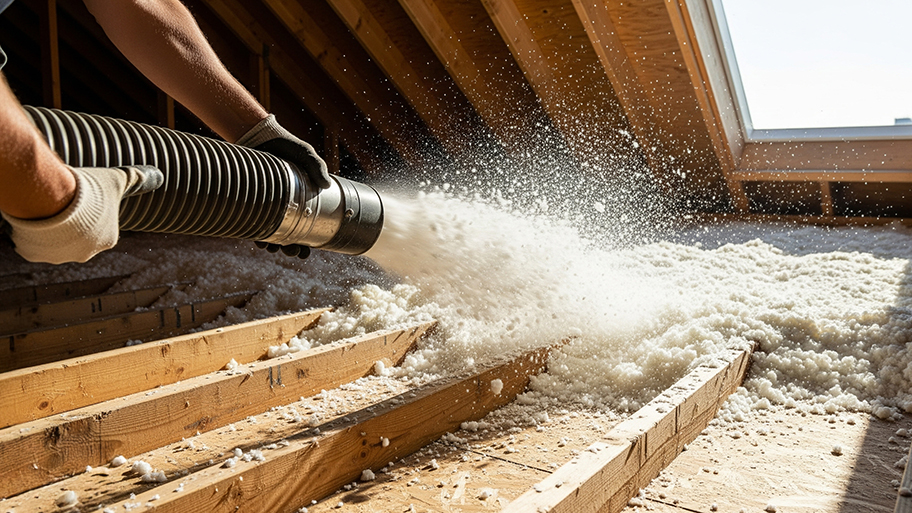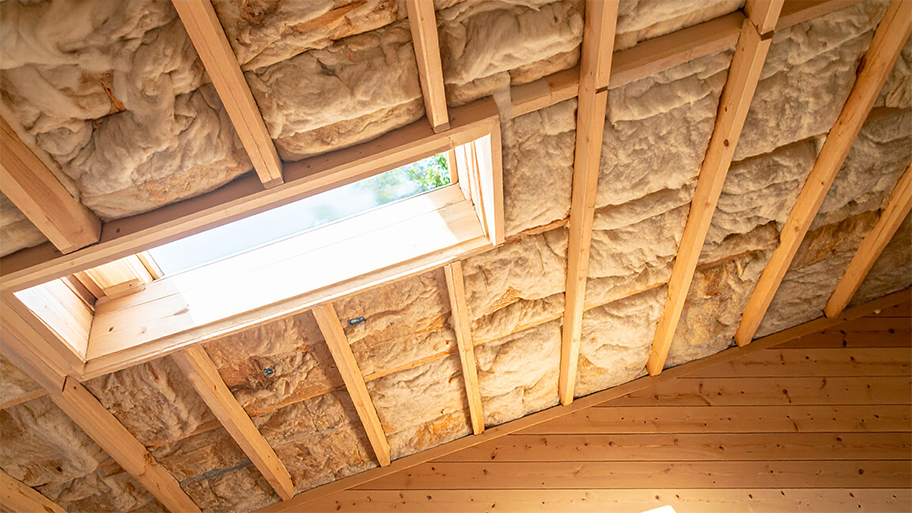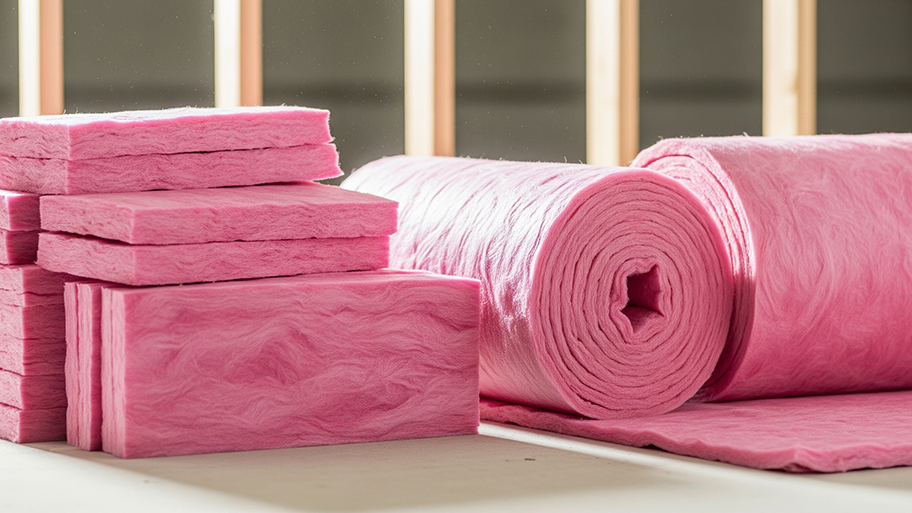
The cost of blown-in insulation costs varies depending on the type of insulation, labor, prep work, and more. Learn more about the cost factors in this guide.
While adding new fiberglass to your home offers tons of "green" and money-saving benefits, DIY fiberglass insulation comes with health hazards


Fiberglass insulation is affordable and effective, but the installation process can be hazardous due to the small glass fibers that reinforce it.
Coming into contact with fiberglass can pose health risks, including skin and eye irritation, as well as respiratory issues.
Once installed in walls and ceilings, fiberglass is contained and won't pose health risks in everyday life.
Labor costs between $40 and $80 per hour, and an insulation pro can complete the job faster than a DIYer and ensure that the end result is safe.
Fiberglass is a popular type of insulation. It’s easy to install and quite affordable compared to other options. But is fiberglass dangerous, and if it is, does that mean you should consider an alternative insulation type?
The quick answer: Yes, fiberglass insulation can be dangerous when it comes into contact with your skin and eyes and when it’s inhaled. But why is fiberglass dangerous? To understand, we’ll need to take a closer look at what this material is.
As the name suggests, fiberglass insulation is a woven product made of plastic that is reinforced with small fibers of glass. This material is strong and durable—and great for building insulation and even soundproofing. This man-made material, though it looks soft and fuzzy (typically in pink or yellow), can be harmful when you come into contact with it.
If fiberglass is dangerous, why would we use it for insulation? Once it’s in our wall and ceiling cavities, we won’t come into contact with it in our everyday lives—and it becomes a quite safe and practical material.
Here are a few of the key benefits of using fiberglass as insulation:
Fiberglass is affordable. Compared to the cost of spray foam insulation or the cost of blown-in insulation, fiberglass is very affordable.
Fiberglass is easy to install. While most homeowners should still hire an insulation pro to tackle the job, fiberglass insulation is easier to install than other types of insulation if you’re up for the task.
Fiberglass can add comfort and reduce your energy bills. Most notable, of course, is fiberglass’ effectiveness as an insulator. While other types of insulation may be more effective, fiberglass still does a solid job at slowing heat transfer and thus better helping you regulate temperatures in your home. This leads to increased comfort and lower energy bills.
Thinking of installing fiberglass in your home? There are several fiberglass insulation dangers to be cognizant of when working with this material.
If your uncovered skin comes into contact with fiberglass, it's very easy for the tiny shards of glass within the fiber to cut your skin. Those cuts can create severe itching and irritation.
While you may think you’re breaking out in a skin rash after touching fiberglass, those markings are probably cuts.
If fiberglass comes into contact with your eyes, your eyes are likely going to become red, irritated, and swollen. Always wear proper eye protection when working with fiberglass.
Fiberglass particles are easy to inhale. Once the tiny glass fibers enter your body, they can actually cut and penetrate your organs and tissues. Some common signs that you’ve inhaled fiberglass include:
Sore or irritated throat
Painful nasal passages
Irritated, sore lungs
Trouble breathing
If you suffer from health conditions like asthma or bronchitis, exposure to fiberglass can exacerbate your symptoms. It could also trigger a respiratory emergency if you have compromised or vulnerable airways. Lastly, ingesting fiberglass particles can cause severe stomach pain and irritation.
Fiberglass is a suspected carcinogen. While some studies have shown an increased cancer risk in mice when lung tissue was exposed to fiberglass, the jury is still very much out when it comes to the cancer risk in humans. Any contractor you talk to will tell you that the protocol is to limit direct contact by as much as possible.
However, concerns over fiberglass shouldn't be confused with the confirmed link between lung cancer and asbestos. These are two different substances.
Fiberglass isn't considered dangerous in a passive way once it's installed in your home. The health hazards associated with fiberglass are only relevant when we're talking about direct contact and exposure.
Although fiberglass can be dangerous, its merits as a cost-effective insulative material mean many homeowners still use it to insulate their homes. That’s totally fine—just make sure you understand how to safely handle fiberglass if you go this route.
Fiberglass poses several risks during installation:
Contact with skin: First and foremost, fiberglass requires manual installation. Unlike with blown-in insulation, where a machine can literally blow materials inside wall cavities, you’ll install fiberglass by hand, meaning you’ll make the cuts and position the material yourself. That provides ample opportunity for fiberglass to come in contact with your hands, arms, and other skin areas.
Contact with eyes: Similarly, if you have any glass fragments on your fingertips and rub your eyes during installation, you could easily scratch your cornea and cause irritation.
Inhalation: Direct skin contact is not the only danger posed by fiberglass. It can be very easy to inhale fiberglass particles while you’re working, posing risk to your throat, lungs, and stomach.
To avoid these fiberglass risks during installation, you’ll need to wear the proper safety gear and take several precautions:
Keep kids and pets away during installation: In a bigger house, simply corral pets and small children in a different area during the installation. In smaller homes, it may make more sense to have children and pets stay with a friend or family member in another home.
Research installation before you begin: If you’re tackling the work yourself, make sure you read detailed guides on how to cut insulation and how to install insulation. Proper installation ensures you won’t expose your family to long-term risks by making mistakes during the process.
Wear long sleeves and gloves: Make sure no skin on your hands or arms is exposed. We recommend tucking long sleeves into your gloves (or taping the gloves and sleeves together). Wearing pants instead of shorts is also a good idea.
Use eye protection and a respirator mask: Always put on safety goggles and a respirator mask before working with fiberglass to avoid contact with your eyes and to keep from inhaling the material.
Keep the area well-ventilated: Open doors and windows and strategically place box or pedestal fans facing out the windows.

While installing fiberglass insulation, use fans with open doors and windows to keep the area well-ventilated. Even so, you should wear a respirator mask during the whole installation.
When you’re finished with the installation:
Seal all unused fiberglass scraps and safely dispose of them in your outside garbage.
Use wet moths and cloths to clean up the fiberglass particles. You can also use a vacuum with a HEPA filter to clean up—just avoid dry sweeping, as it can spread particles in the air.
Place your clothes directly in the washing machine. Wash these clothes separately from all other laundry.
Thoroughly wash your hands. Take a shower, including washing your hair.
Installing fiberglass insulation as a DIY project is doable, but there are a lot of dangers to consider. For many, it might be easier to hire a pro.
Handling fiberglass insulation carefully is crucial to your safety. If you have any doubts about your ability to safely install fiberglass insulation—or you simply don’t have the time or know-how to do the job—look for a top-rated insulation company near you.
Fiberglass insulation costs between $0.30 and $1.50 per square foot, but those costs increase when you factor in professional labor. Insulation companies may charge between $40 and $80 per hour. That means a day’s work could cost between $320 and $640.
For many homeowners, it’s well worth the cost. Professional insulation companies can get done in a day which may take you all week. Plus, they’ll ensure safe and effective installation, and you won’t have to spend any money on installation tools or protective gear.
Fiberglass is dangerous, but it’s also an effective and affordable insulation material. You can absolutely use fiberglass to insulate your home; just proceed with caution. If you’re not totally confident working with the material, call up a pro and leave the tough work to them.
Our install was 23 May and I regret it. First: When they said they were complete and asked if I wanted to take a look. I did and a large area over our master bath was not covered. When I asked why they said there was plenty insulation already and it didn't need covered. ? Remembering the...
The Batman are the best! They are so quick, efficient and friendly. They have done everything for our house from attic clear out and re-insulation, to checking on birds nesting in our gutters. I would recommend to anyone!
Sorry so long but I feel it is necessary to get the whole story. We hired Kitchens Redefined for a kitchen remodel which included a new island, gas cooktop cabinet, double wall oven cabinet, quartz countertops & painting cabinets that were not replaced. We were really excited for this project...
Like with many businesses you get what you pay for! I could have found another company that is cheaper but I know good service when I see it! This company is exceptional in every aspect. My insulation has made a tremendous difference before they were even finished! My recommendation is...
The Koala team provided a very fair and reasonable estimate and performed the work exactly as requested. Job was scheduled within days and completed in the exact time frame they had initially provided in the estimate. The team is extremely responsive and very friendly. I would recommend them...
Jake with Storm Irrigation is extremely knowledgeable, trustworthy, and dependable. We bought a new house and he has installed both the lawn sprinkler system and the outdoor landscaping lights. Both work excellently, and the lighting is arrestingly beautiful…well worth the investment. Jake...
It was the most wonderful job He is a wonderful person I have never worked with anyone like him I have high praise for him and his company
I’m very pleased with our basement renovation and I will hire them again for the next project. Brad and his team were phenomenal to work with and they helped us design a living space that was a perfect fit for our needs. The price quote was broken down really well so we knew exactly what the...
This is second time I used Arbor Aesthetics. The tree removal was done neatly not bothering other landscaping. The crew was efficient, professional and concerned to do good job. Jeff, the owner was efficient, kept me informed and everything came off a planned. This is the best tree service I...
We received multiple quotes and selected Dr. Exteriors because we liked the fact that he assessed the situation and recommended corrective action to fix the problem rather than just focusing on the product he was selling. Dean said that we may not need to replace two of the windows with...
From average costs to expert advice, get all the answers you need to get your job done.

The cost of blown-in insulation costs varies depending on the type of insulation, labor, prep work, and more. Learn more about the cost factors in this guide.

Insulating your attic can massively improve your home’s efficiency and reduce electric bills. Use this guide to find out what attic insulation will cost you.

Crawl space insulation costs vary by size, insulation type, and material. Read this guide to learn how much your crawl space insulation could cost.

Your home's ceiling insulation cost will depend on several factors, including the project size, the type of insulation you use, and the R-value.

How much does insulation save on energy bills? It depends on where you live and the type of insulation you install.

Learning how to install insulation requires technique, patience, and safety training. Read our guide to see if it’s a DIY project you should take on yourself.